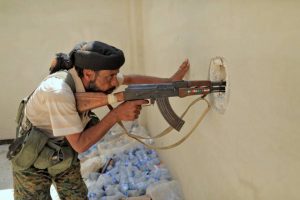U.S.-backed forces now have Islamic State fighters surrounded in central Raqqa, a Syrian Kurdish commander said, but he predicted that driving the militants out could take up to four months.
“We’ve cleared about half of Old Raqqa … and we’re advancing on all axes,” said Haval Gabar, the 25-year-old commander from the Kurdish YPG militia who is directing the assault on the Old City front in Islamic State’s Syrian stronghold, like reported by japantimes.co.jp.
Units of the Syrian Democratic Forces, an alliance dominated by the YPG, fully linked up in Raqqa’s southern districts on Tuesday, encircling the militants in the city center, which includes the Old City,
“The day before yesterday there was still a small gap,” Gabar said on Wednesday. “Yesterday it was closed. We are now pressing towards Mansour and Rashid districts.”
From his command post, a former Syrian government police headquarters overlooking the Old City walls, Gabar hunched over maps and radioed orders to YPG units 400 meters (yards) ahead in the densely built city center.
As he spoke, the sound of machine gun fire barked over his walkie-talkie while airstrikes staged by the U.S.-led coalition slammed into targets nearby.
The SDF, backed by the airstrikes and coalition special forces, have been fighting since June to clear Islamic State from Raqqa city, its de facto Syrian capital. A separate campaign drove the group from its Iraqi stronghold of Mosul last month.
However, the multiphased Raqqa offensive began already in November, capturing surrounding towns and villages, encircling the city and cutting off Islamic State from the north, east and west.
But the advances are proceeding cautiously, officials say, as Islamic State uses snipers, car bombs and booby traps, and forbids civilians to leave, prolonging the effort to flush the jihadis out.
Initial predictions by the YPG that the Raqqa battle would be over in a matter of weeks were wrong.
“It could take another three to four months to finish Raqqa,” Gabar said. The SDF was advancing steadily, but he added: “They’ve laid many mines, that’s one of the biggest difficulties. As for car bombs, they don’t use them every day, but if our forces are advancing down a street, then they deploy them.”
As he spoke, a huge blast shook the building, and a plume of smoke rose from inside the Old City — a car bomb had been hit by an air strike.
The radio crackled with reports of SDF casualties. A medic working at the command post, who gave her name as Jiyan, did not give a figure for the number of wounded being brought in, but said it was lower than in some previous battles.
“There are not as many fighters being killed and wounded as last year in Manbij,” she said, referring to the town northwest of Raqqa captured by the SDF last year.
SDF spokesman Talal Selo said on Tuesday that mines were slowing movement even where Islamic State — known by its opponents as Daesh — had withdrawn.
“In the northern area there is no Daesh presence, but at the same time our forces are not getting closer in because Daesh has rigged these areas with enormous amounts of explosives and mines,” he said.
The further forces advance into Raqqa, the tougher it has become, fighters in Gabar’s unit and other SDF militias said. Militants from the Russian region of Chechnya were particularly deadly.
“There are many snipers. They’re good, especially the Chechens,” YPG fighter Adel, 20, said, pointing at small holes in the walls of the police headquarters that the militants had used to shoot from when they held the building.
Through large open windows in the command post, some barricaded with tables to shield the unit from sniper fire, the ancient mud-brick Old City walls were visible, including one point where the SDF breached them to get through.
Gabar said that despite resistance, several hundred militants had surrendered themselves, and estimates not more than 1,000 are left. He believes their morale “is zero.
“Maybe 600 Daesh have surrendered. It’s mostly foreign fighters left in the city now. Those with families tend to be the ones to hand themselves over.”
A handful of civilians have trickled out of the city each day, but most cannot leave. Up to 50,000 civilians are trapped inside, the United Nations says.
The U.S. coalition and its allies say they take care to avoid civilian casualties, another reason for advancing cautiously. Many buildings around the command post were reduced to rubble.
The U.N. says coalition air strikes have killed at least 300 civilians in Raqqa since March.
The SDF are keen to finish the battle. “We’ll be done soon,” said a YPG fighter. “We kill 10 to 15 Daesh a day.”



